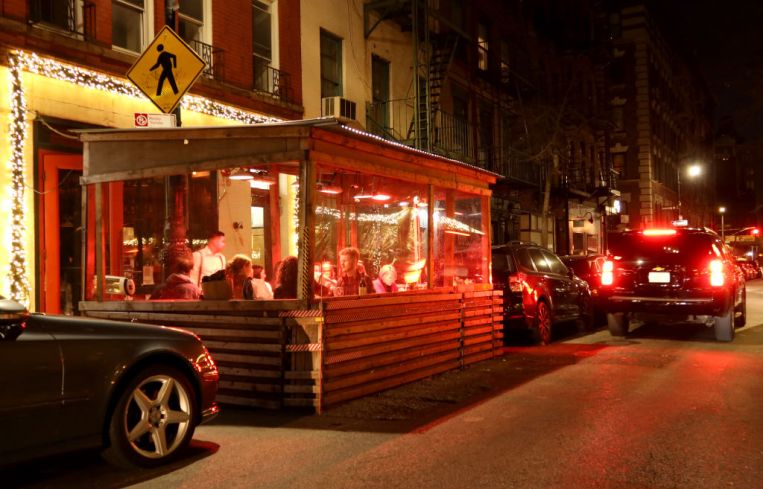New Rules Might Make NYC’s Outdoor Dining Program Unappetizing to Eateries
By Aaron Short August 10, 2023 12:50 pm
reprints
A new measure making New York’s popular outdoor dining program permanent has some city leaders and stakeholders concerned that, without substantial changes to the law, diners will have a significantly worse experience eating outside in the future.
The New York City Council approved legislation last week that will allow restaurants to install removable structures on roads and sidewalks, as long as they obtain permits and comply with new design rules not yet set in stone.
But restaurants will have to dismantle the streeteries they built at the start of the pandemic by November 2024, and fork over money for new structures if they want to continue entertaining customers al fresco. They will only be able to keep those sheds up for eight months of the year, and will likely be responsible for storing their new dining abodes during the winter.
Those requirements, and other new rules, could discourage thousands of restaurants from participating in the outdoor dining program, city leaders argued.
“I believe New Yorkers come to expect a pleasant dining experience in a roadway, and a seasonal setup of tables and chairs just is not it,” Brooklyn Councilmember Lincoln Restler, who voted against the legislation, told Commercial Observer. “When restaurants and restaurantgoers come to realize how inadequate this bill is, there will be a lot of pushback and concern.”
The outdoor dining bill has the support of the mayor and hospitality industry advocates, who have sought a year-round permanent program since restaurants installed makeshift dining sheds after the pandemic hit three years ago.
But some residents in restaurant hotspots complained about sidewalk crowds, noise from customers, eyesores from dismantled structures and garbage pileups, which led to months of contentious negotiations in the council. At the same time, one group of opponents sued to curtail the mayor’s emergency orders establishing the outdoor dining program, and demanded environmental reviews.
As a result, the new bill restricts the program to occur between March 31 and November 30; stipulates that the streeteries no longer be fully enclosed spaces; and creates a four-tier permit system based on a restaurant’s location, with those below 125th Street in Manhattan receiving the highest fees.
Once the mayor signs the bill into law, the New York City Department of Transportation (DOT) will begin to draw up rules for its outdoor dining program, as soon as this fall. That’s when key details of the law — including the application process, permit fees, storage requirements and alternative uses for roadways — will become set in place. (A DOT spokesperson did not respond to questions about the rule-making process.)
The biggest focus will likely be on design standards, which DOT has not yet made. Advocates and restaurant leaders vowed to push the city to allow weatherproofing the structures, authorize customization and permit the use of materials that will last beyond one season.
“We would like the city to provide very clear standards that third parties could easily design and build, and restaurants could further customize with their own colors and planters so they’re all unique and represent the individual restaurants,” Andrew Rigie, executive director of trade association the New York City Hospitality Alliance, said.
Companies are already gearing up to offer components that will comprise the next iteration of outdoor dining structures. Re-ply, a New York-based design startup and subsidiary of BVN Architecture, has created several barriers, platforms and benches with recycled, hard plastic layers that wrap around a steel chassis. Each part can be customized with a variety of colors and patterns. More importantly, rats cannot chew through them easily.
“Rats are good at chewing through plywood, and part of moving to a more durable material is moving through more rat-proof materials,” Nick Flutter, co-founder of Re-ply, said. “We’re also the only ones with a platform that can be easily lifted. The space underneath these platforms after a couple of years gets quite feral, and being able to lift the floor and clean under there is going to be a big plus to cut down on the rat situation.”
Then there’s the question about what will happen to curb space that has been devoted to outdoor dining since 2020. Some residents who oppose the program want the roadway to revert back to parking for drivers. Transportation advocates worry that this reversion could create confusion and conflict on streets where restaurants will want to operate for several years.
“We want to see some solution that provides some type of public amenity, so that we’re not seeing an annual fight for parking over the offseason,” Maulin Mehta, the New York director of the Regional Plan Association, said. “It’s important for communities to not continually see parking spaces go in and out if we’re saying businesses can get a multiyear license. There should be a design designation to help solidify in the neighborhood’s mind that this is not for parking.”
Restler said he would closely watch the city’s rule-making process to ensure that the experience of dining outdoors doesn’t degrade once the permanent program launches. So far, he’s not optimistic that restaurants will be able to build out removable structures for customers to enjoy.
“The lack of waterproofing [and] protections from sun and from cold will make this a much less enjoyable experience for New Yorkers,” he said. “I hope we’re ultimately able to get to a better outdoor dining program than where we landed with this legislation.”


